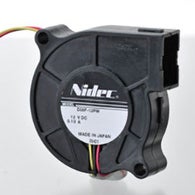Implemented Solutions
Pushing the Limits of Miniaturization with our Ultra-Thin & Ultra-Small Fans
Less than 3-mm thick and with 20-mm sides—our ultra-compact cooling fans are a result of cutting-edge design and state-of-the-art analysis and manufacturing technology

The trend of increasingly thinner laptops is still going strong. At the same time, CPU clock speeds are increasing due to a combination of higher screen resolutions and better video playback performance. As a result, the requirements on laptop cooling fans are strict; on the one hand, they have to be capable of sufficiently cooling the CPU, while on the other hand they are required to be compact enough to accommodate space restrictions posed by progressively thinner laptops. Currently, most laptop cooling fans are between 3.5 and 4 mm thick. However, at Nidec we have gone even further and developed cooling fans that are thinner than 3 mm. Although, with our technology, it is possible to create even thinner fans, our calculations of the optimal volume ratio between the space in front of the air inlets and the fans themselves, based on analysis of air flow and available internal space, have shown that the optimal dimensions are slightly thinner than 3 mm.
In order to design even thinner fans while maintaining the air flow necessary to cool CPUs operating at high clock speeds, the number of fan blades have to be increased from the 13 rotating blades of our 10 mm thickness fans. At the same time, attention has to be paid to quiet operation as well—another important feature emphasized in the design of laptops. Generally, fan noise tends to take the shape of peaks as it mainly consists of an overtone that is a multiple of a fundamental frequency defined as the number of fan blades multiplied with the rotational speed of the fan. When designing our fans, the number of blades is carefully chosen with the aim of dispersing these peaks. Moreover, this effect is further boosted with an unequal blade spacing design. In addition, we utilize advanced coupled analysis technology developed in-house to quickly find the sweet spot between air volume and noise through synthetic analysis of the air flow and the noise generated as the air moves from the inlet, through the fan and towards the CPU.

The metal molds used to cast the fan blades are designed and manufactured in-house as well. One of our key strengths lies in our injection molding capabilities that allow us to mass produce ultra-small resin fan blades without compromising their carefully designed shapes. Reducing the thickness of the motors—the hearts of the fans—presents its own set of challenges as well. In particular, the magnetic circuits, the cores and the winding stand out as requiring special attention when designing thinner motors. Wires with a diameter less than 0.1 mm are used for the electromagnetic coils. Furthermore, the winding process has to be controlled with utmost precision to ensure the number of turns necessary to generate the desired torque. This obstacle is overcome by rapidly developing new specialized coil winding machines—or modifying existing equipment to meet the necessary specifications—using technology available within our company group.


Developer's Comment
We are dedicated to pushing the limits further with even smaller and thinner fans currently in production. Laptop models capable of performing exceedingly processor-heavy tasks, such as video editing, are becoming more and more common. These laptops make use of CPUs with very high clock speeds, yet are still required to follow the recent trend of thinner designs. The cooling fans used in these laptops face very strict requirements: they are expected to be extremely thin while also providing large amounts of air flow. Armed with our peerless fluid dynamic bearing technology built up with our HDD spindle motors, we aspire to the top position of the cooling fan motor industry.